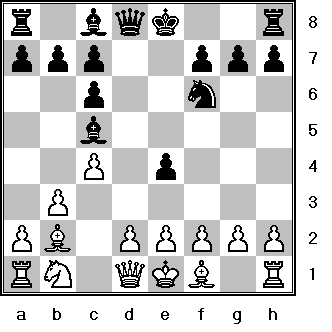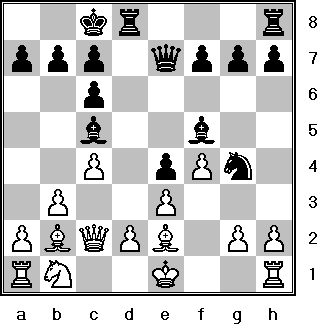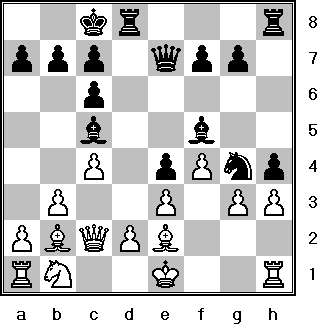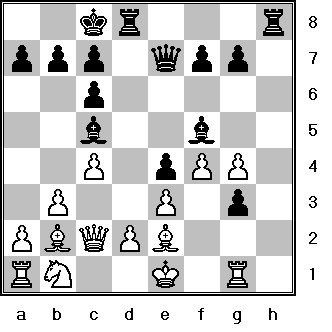-
1. b3
The Nimzovich-Larsen Opening. Larsen's own opening when he was one of the world's Top 5 Players.
1...e5
2. Bb2 Nc6
3. c4!?
Preventing d5.
3...Nf6
Black develops naturally.
4. Nf3!?
Safer was 4. d3
Trying to entice the KP to advance in true hypermodern form, but this also has its drawbacks as it increaces blacks control of space in the center and on the kingside.
4...e4
5. Nd4 Bc5
6. Nxc6
Swapping off a set of pieces to relieve his cramped position
6...dxc6!

Spassky's idea is to create pressure along the newly half-opened d-file. It is noteworthy that nearly all the squares on the d-file are now doubly attacked.
7. e3 Bf5
8. Qc2 Qe7
9. Be2!?
Maybe an unnecessary move.
Better was 9.Nc3! 0-0-0 10.a3! Bd6 11.b4 c5 12.b5 Qe6!? 13.h3 h5 with chances for both sides.
Or 9.a3!? This move was mentioned as a possibility by both Spassky AND Larsen after the game.
9...0-0-0
Black clearly has the better practical chances, as he has developed all of his pieces.
10. f4?!
Trying to gain space on the King-side and block key lines for White's pieces. Slighty better was 10.Bxf6 Qxf6 11.Nc3 though black has an edge - GM B. Spassky ... in the Match Bulletin.
10...Ng4!

Black threatens possible sacrifices on d2 and e3.
11. g3
To stop ...Qh4+
White already is having a tough time finding a good defense.
- Life maste AJ Goldsby gives the following line:11.Bxg7!? Rhg8; 12.Qb2 Kb8 13.Bxg4 Qh4+ 14.g3 Qxg4 15.Bf6 Rd3 16.Qe5 Bxe3!
- GM Emms gives the variation of: 12.Bb2 Bxe3! 13.dxe3, Or 13.Bxg4 Rxg4 14.dxe3 Qh4+ 15.Kf1 Rxg2!! 16.Qxg2, (If 16.Kxg2 Bh3+; 17.Kg1 Qe1#.) 16...Rd1+; 17.Ke2 Bg4+ and Black is winning easily. .
- Or 11.0-0!? Rxd2!! 12.Nxd2 (12.Qxd2? Bxe3+ 13.Kh1 Bxd2 black is winning) 12...Nxe3; 13.Qc1 Nxf1+ 14.Kxf1 Qh4! "with a winning attack" 15.g3 Qxh2; 16.Ke1 e3 "leads to total annihilation." - GM J. Emms.
- Or 11.Bxg4 Qh4+ 12.g3 Qxg4 "leaves White pathetically weak on the light squares." - GM J. Emms.
11...h5!
Black wants to open the h-file.
12. h3
Not much choice here, Larsen must run this pesky Knight off.
Soltis gives some of the fireworks that could have happened after the move, 12. Nc3!? eg, 12.Nc3 Rxd2!! 13.Kxd2, Or 13.Qxd2 Bxe3 14.Qc2, GM's Soltis & Emms give the variation: 14.Qd1 Nf2! 15.Qc2 Nxh1 16.Nd1 and now 16...Qc5! with a winning attack --AJ Goldsby.
12...h4!!

Attempting to pry open the h-file.
Spassky is offering to sacrifice TWO minor pieces with this move!
IM Bernard Cafferty, (in his book, "Boris Spassky: Master of Tactics."); writes: "After this fine move, the hall bubbled over with enthusiasm." (The spectators had to be continually quieted.) Cafferty continues: "B.H. Wood and I, who were sitting in the very front rows; feverishly analyzed the acceptance of this offer on a portable, magnetic set. (Especially the variation after 13. Bxg4.) After some initial skepticism our conclusion was that Black should win, but I must admit ... - in all honesty - that we did not find Spassky's coup de grace ... at move 14."
"It is incredibly difficult even to visualize Black's spectacular move at this stage, never mind work it out to a forced win. But this is exactly what Spassky does!" - GM John Emms.
Also possible was: 12...Rxd2!? ; 13.Nxd2 Nxe3 ; 14.Qc3 Rd8 "with a strong attack." - GM John Nunn.
13.hxg4
White accepts the offer
If 13.Bxg4 Bxg4 14.hxg4 hxg3 15.Rg1 Rh1!! The same idea Spassky had in the game. 16.Rxh1 g2 17.Rg1 Qh4+ 18.Kd1 (Or 18.Ke2?! Qxg4+ 19.Ke1 Qg3+ 20.Ke2 ( Or White could try: 20.Kd1 Qf2; 21.Qxe4 Qxg1+ 22.Kc2 Qf2 winning for black. 20...Qf3+ 21.Ke1 Bxe3! Black is winning) 18...Qh1!; This seems to be the strongest, and the move picked by virtually all computers. (The main idea is if Rxh1? Black responds by capturing the Rook and promoting to a new Queen. Analysis by Life Master AJ Goldsby based on notes by GM Soltis and GM John Emms and corrected through computer analysis. Or 13.Nc3!? hxg3! with an overwhelming attack for Black." Soltis
13...hxg3
Black has opened the h-file, one of the main ideas of the attack.
14.Rg1!?

The only possible defense.
The other alternative were clearly losing for Black. 14.Rxh8?! Rxh8 15.Bf1 Rh1; 16.Nc3, ( 16.Ke2? Bxg4+ and Black gives mate in 4 moves) 16...g2 Black is winning, White cannot prevent his opponent from getting a second Queen.
14...Rh1!!
GM Emms writes: "This move elevates this game onto an altogether different plane. Black sacrifices a whole Rook simply to gain one tempo to push his g-pawn. The one tempo, however, makes all the difference!"
Soltis writes: " White had banked on the possible defense of: 14...Qh4 15.Rg2 Qh1+ 16.Bf1 Bxg4 17.Qxe4"
GM J. Emms continues the analysis: 17...Rhe8 18.Be5, (Or 18.Qc2 Bxe3! 19.dxe3 Rxe3+)18...f6 19.Nc3, Black is clearly better.
15. Rxh1 g2!
This is the true point of the combination.
16. Rf1
Probably the best.
White could have played: 16.Rg1 Qh4+; 17.Kd1 Qh1! 18.Qc3 Qxg1+; 19.Kc2 Qe1! Obviously 20.Na3 Qxe2; 21.Rg1 Bxe3! Black is obviously winning --Line by AJ Goldsby.
16...Qh4+

Usually when the Queen enters the attack, it is decisive.
17. Kd1 gxf1Q+
White Resigns.
0 - 1.
After 18.Bxf1 Bxg4+ 19.Kc1 (19.Be2 Qh1#) 19...Qe1+ 20.Qd1 Qxd1# white is mated.

Tactical Themes: line opening, enticement, square vacation, pawn promotion, pin
Mating Themes: King in the Center, H-File mate, Diagnol mate, Bishop and Queen Mate
I consider this to be the 4th Greatest Attacking Game of All Time!